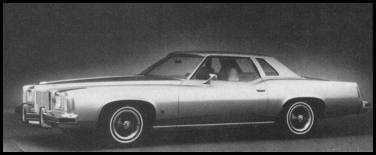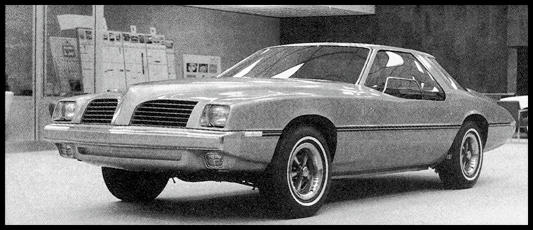
The
slightly-restyled '74. |
1974
The 1974 model year saw some minor cosmetic changes and little else. The revised grille treatment did not extend below the bumper. Instead, the bumper was thicker to compensate for the change, accented with large, upright guards. The headlights were now housed in taller, more rectangular bezels. Overall, the front of the car was more massive-looking.
Out back, the taillights were now paired vertical units, and the sides received sculpting lines.
Powerplant offerings included the 400 4-barrel with 200 or 225 hp and the 455 4-barrel, which held its 250 horses and was standard in the SJ. Again, automatics were the only trannys available.
The 1973 Arab oil embargo really ate into the intermediate car market, as gas prices went through the roof. In response, buyers flocked to the smaller, more fuel-efficient subcompacts made here and abroad. Not surprisingly, 1974 Grand Prix sales dropped off to 99,817 units, a decline of 57.3 percent. Still, '74 was the No. 3 year for GP sales.
1975
The 1975 GP was essentially a carry-over from 1974, in terms of styling. The few changes made were concentrated in the grille, which received fewer vertical slats, and in the taillights, which were now more vertical.
The Grand Prix lineup now consisted of three models, all based on the same body. First was the standard coupe, next up was the SJ, which was now the "sporty" version, followed by the new luxury LJ. The three varied somewhat in terms of available upholstery and trim levels.
This was the first year for mandatory use of unleaded fuel and catalytic converters, so 1975 models saw some significant changes in emissions control devices—and a subsequent reduction in horsepower. All Pontiac V8s received the High Energy Ignition System, which was said to deliver three times the firing power to the spark plugs, and allowed for a wide (0.060-inch) plug gap. This resulted in more complete combustion, which aided efficiency and reduced emissions somewhat.
The base engine was a 400 4-barrel, now advertised at 185 hp, down a full 40 horses. A federally certified 400 2-barrel was also optional in all models. The 455 4-barrel put out a rather wheezy 200 horses, and was standard in the SJ. Whether the power reduction in the Poncho engine lineup was actually as severe as advertised has been the topic of some controversy, but either way, it wasn't a good sign for enthusiasts.
Production figures for the Grand Prix continued to drop. The 1975 total was 86,582 units, of which 64,581 were standard models, 7,146 SJs, and the remaining 14,855 the new LJ coupes.
Pontiac built a very unusual concept vehicle in this period. While it was not a glimpse at the next-generation GP, it was intended to preview upcoming features of future Grand Prixs. The car had a hand-formed aluminum body and a non-production, all-aluminum 250-cubic-inch Pontiac V8. Unfortunately, the car was never completed and never shown, most likely because it was far more advanced than the vehicles it was intended to preview. It disappeared without a trace and has not been seen since.
NEXT >
| Although it was never shown—or even
completed—this aluminum-bodied Grand Prix, circa 1974-76, would have been quite a show-stopper. Powered by a non-production
250-cube aluminum Pontiac V8, this GP also featured suicide doors, a clamshell hood, wraparound rear window and gullwing luggage
compartment lids. Due to the curvature of the side glass, the windows were fixed, although a small window did open for use at toll
booths. |
  |
|